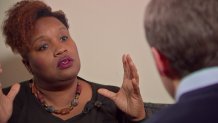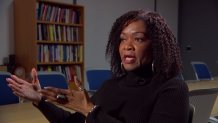Dallas police plan to attack soaring violent crime with computer analysis, trying to pinpoint areas of the city where crimes may be more likely to happen next. It’s a strategy often called “predictive policing.” But does it work?
Dallas Chief of Police Renee Hall said at a recent news conference that her version of the strategy, known as the “Risk Terrain Modeling,” will be “huge."
But Hall stopped short of promising success.
“We will be very transparent if predictive policing is not successful for us.” - Dallas Chief of Police Renee Hall
NBC 5 Investigates traveled to Kansas City, Missouri, where police are already using a computer model, known as RTM, that includes tactics that Dallas will use as well.
“We’ve been very fortunate in Kansas City to see some very positive outcomes so far,” said Kansas City Police Capt. Jonas Baughman, who said crime has come down in 12 of the 13 zones where they have used Risk Terrain Modeling to target violent crime over the last 11 months.
We also heard concerns from those who suspect the program may just be shuffling crime from one small area to another, and others who fear computer-driven policing could unfairly impact minority communities.
“I think that a lot of care should be taken to ensure its equitably deployed,” said Gwen Grant, president and CEO of KC’s Urban League.
Risk Terrain Modeling started with two professors at Rutgers University. It uses computers to analyze a city, block by block, and to identify environmental factors like transit stops, vacant buildings or certain businesses, like liquor stores, that could make crime more likely to occur in a neighborhood.
The theory is that if elements of the environment that are attracting criminals are removed, then criminals may look for opportunities elsewhere.
In Kansas City, Baughman said RTM allowed police to realize some bus stops near liquor stores had become magnets for violent crime and robberies.
“They’d use the bus stop as an excuse to pretend they were waiting for the bus,” Baughman said.
At one location, violent crime was cut by 36% by simply removing a bus stop, he said.
Bobbi Baker-Hughes said in her Eastside Kansas City neighborhood police used RTM to first identify high-risk locations and then reached out to business owners and brought in social workers to help the people who live there.
“We saw crime drop. We saw bad guys being taken away. And we saw good resources being brought in,” Baker-Hughes said.
But Toya Like, a criminologist in Kansas City, said that when one area becomes less inviting to criminals, it could mean they’ll just move over to the next area.
“So while you have decreased it in that particular hot spot, you’ve likely increased it in an area that was not dealing with that issue." Toya Like, criminologist
She applauded the creativity in risk-terrain policing, but wondered whether it would work throughout Kansas City, which in recent years has had one of the highest murder rates, per capita, in the country.
“You can have something that, theoretically, philosophically, sounds great, and should have an important influence or impact,” Like said. “But implementing it – that’s a whole different step.”

And with RTM, implementation can vary widely from one city to the next.
Joel Caplan, a former police officer and 911 dispatcher who developed RTM policing at Rutgers University, has made RTM available open-source to anyone who wants to use it online. Because of that, he said, he can’t vouch for what Dallas police will do with it.
“I have not had any interactions with the Dallas Police Department,” Joel Caplan, RTM developer
Caplan has worked in the past with a Dallas anti-poverty nonprofit that will help Dallas police implement its RTM program. But it’s not clear to him how they will use the data on the streets.
Hall’s violent crime reduction plan, which was made public recently, said risk terrain will address issues like “poor lighting and abandoned businesses…” It also said it will be used to “deploy targeted patrols” in grids of 330 feet by 330 feet.
Highlights Within the RTM Plan Include
- “Implement a data-driven, comprehensive approach to address people, places, and behaviors impacting violent crime.”
- RTM will allow Dallas police to better understand the spatial features of specific areas (hot spots), such as poor lighting, abandoned businesses, or vacant land…
- This strategy seeks to reduce crime while implementing community change to prevent it from returning.
Caplan told NBC 5 Investigates his model should not be used to flood neighborhoods with officers.
Rather than using it “single-handedly as a policing tool,” police should partner with other agencies and community groups to change the parts of an area that attract crime, Caplan said.
In Kansas City, police are instructed to visit the business owners, and be aware of their surroundings, while in the areas designated as crime-risk zones.
But they said they are also explicitly told not to stop everyone who moves.
Still, minority leaders are wary that RTM might lead to unfair scrutiny if the computer data zeros in on minority communities and police are not careful about how they approach those “risk zones.”
“You end up targeting or zeroing in on just one population,” said the Urban League’s Grant.

In Dallas, Chief Hall was not immediately available when this story first ran, but she has since told NBC 5 Investigates in an exclusive interview that she plans to cherry pick the parts of computer policing that have proven to work in other parts of the country.
In Kansas City, police said it’s essential for departments using risk terrain to think about what officers will be told to do when they are in a zone identified as “high risk.”

“If circumstances dictate, yeah, you may need to stop a car or arrest a person. But first and foremost, it’s crime prevention and that doesn’t mean you have to arrest someone. And so it’s trying to shift some of those old habits,” Baughman said.
On Tuesday night, part two of this two-part investigative report heads to Los Angeles. Tune in to NBC 5 News at 10 for the conclusion.



